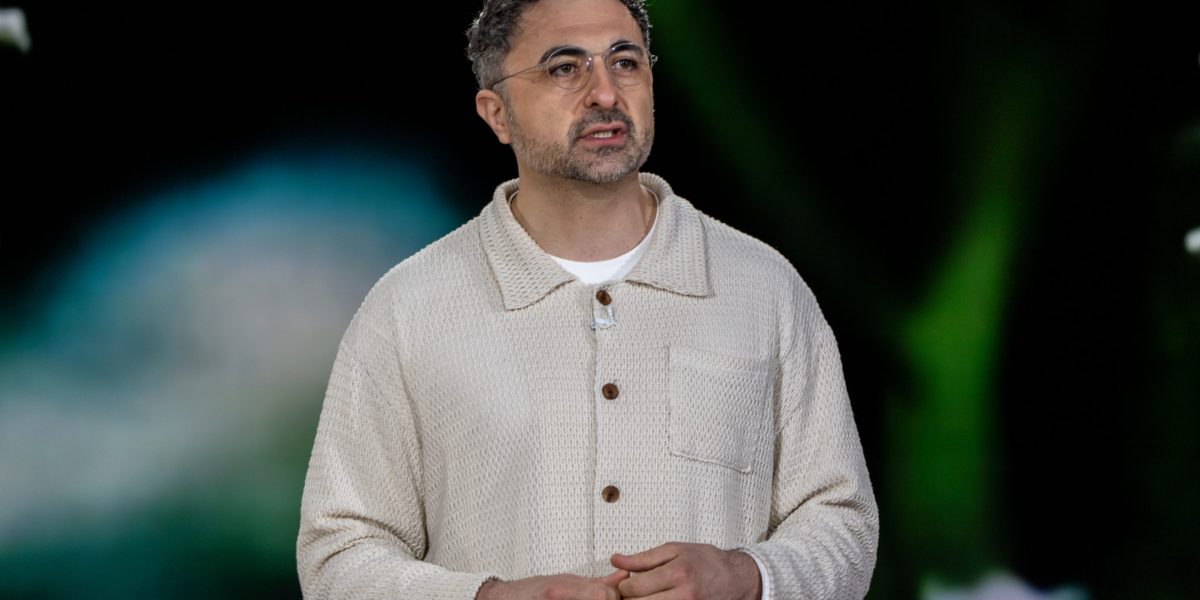A recent review published in Engineering explores the construction and potential applications of spinal cord and peripheral nerve organoids for regenerative medicine in neurotrauma. The article, titled “Engineering Spinal Cord and…
Blog
-

Tracking bats as they hunt birds in the skies above Europe
There are three species of bats that eat birds. We know that because we have found feathers and other avian remains in their feces. What we didn’t know was how exactly they hunt birds,…
Continue Reading
-

Microsoft is distancing itself from longtime partner OpenAI, shunning erotica chatbots: ‘Just not a service we’re going to provide,’ AI CEO says
Microsoft will not emulate the strategies of Elon Musk’s xAI or Sam Altman’s OpenAI in creating “simulated erotica” for its chatbot users, according to the company’s CEO of AI, who warned the bots’ capabilities can be “very…
Continue Reading
-

Lost Salvador Dalí painting bought for £150 sold at auction for £45,700 | Salvador Dalí
To the untrained eye, it looks more like an alien has landed on Chewbacca’s head than a masterpiece by Salvador Dalí.
But the watercolour and felt-tip painting – bought two years ago for £150 – has been sold at auction for £45,700, after…
Continue Reading
-

The Athletic: David Adelman unplugged: On Nikola Jokić and more
Editor’s Note: Read more NBA coverage from The Athletic here. The views on this page do not necessarily reflect the views of the NBA or its teams.
***
DEL MAR, Calif. — The L’Auberge Del Mar hotel, which overlooks the limitless beauty…
Continue Reading
-

Food tax shift could have both environmental and human health benefits
More expensive steak, cheaper tomatoes, but the same total cost for the average basket of groceries at the supermarket. A comprehensive study, led by researchers from Chalmers University of Technology in Sweden has analyzed the…
Continue Reading
-

FDA Grants Fast Track Designation to Zenocutuzumab in NRG1+ Cholangiocarcinoma
The FDA has granted breakthrough therapy designation to zenocutuzumab-zbco (Bizengri) for the treatment of adults with advanced unresectable or metastatic cholangiocarcinoma harboring a NRG1 gene fusion.1
The designation was based on findings from the phase 2 eNRGy trial (NCT02912949), updated results from which were presented at the 2025 AACR-NCI-EORTC International Conference on Molecular Targets. The data will also serve as the basis for the 2026 filing of the agent’s supplemental biologics license application to the FDA.
“NRG1 fusions represent a rare but actionable driver in cholangiocarcinoma, and the data from the eNRGy trial continue to highlight the potential of zenocutuzumab to offer meaningful clinical benefit for these patients. I’m honored to present these findings at AACR-NCI-EORTC, where we can advance the dialogue around targeted therapies in hard-to-treat cancers,” Alison M. Schram, MD, principal investigator of the eNRGy trial and associate attending physician at Memorial Sloan Kettering Cancer Center in New York City, New York, stated in a news release.
What was the design of the ongoing eNRGy trial?
The global, multicenter phase 1/2 eNRGy trial was designed to evaluate zenocutuzumab in patients with advanced NRG1-positive solid tumors, including cholangiocarcinoma, pancreatic ductal adenocarcinoma, and non–small cell lung cancer (NSCLC).2 To be eligible, patients had to be at least 18 years of age and have received a diagnosis of an advanced or metastatic solid tumor with a NRG1 gene fusion. Patients also had to be previously treated or unable to receive standard therapy and have an ECOG performance status between 0 and 2.
All patients received 750 mg of zenocutuzumab intravenously over a 2-hour infusion every 2 weeks until progressive disease or unacceptable toxicity. Tumor assessment was performed every 8 weeks. The first infusion of zenocutuzumab was administered over 4 hours and accompanied by premedication with antipyretics, antihistamines, and glucocorticoids to minimize the incidence of infusion-related reactions (IRR).
What data were presented at the 2025 AACR-NCI-EORTC meeting?
The cholangiocarcinoma cohort served as the focus of the AACR-NCI-EORTC presentation. A total of 22 patients were enrolled in the safety analysis cohort, 3 of whom were excluded from the primary efficacy cohort (n = 19) due to prior HER3-directed exposure and the presence of another oncogenic driver (n = 1).
The primary end point was investigator-assessed objective response rate (ORR) per RECIST 1.1. Secondary end points included duration of response (DOR), clinical benefit rate (CBR), and progression-free survival (PFS) per investigator assessment, as well as DOR, ORR, and PFS per blinded independent central review, and safety.
The median age was 57.5 years (range, 23-82), and most patients were women (55%). ECOG performance status was predominantly 0 (63%), and anatomic location was largely intrahepatic (82%). Most patients also had stage IV disease at screening (95%) and had discontinued treatment (82%) because of progressive disease (68%).
With respect to treatment history, 89% of patients received prior systemic therapy, which included chemotherapy (84%), immunotherapy (16%), anti-VEGF therapy (5%), and transarterial chemoembolization (5%). The median number of prior treatment lines was 1 (range, 0-4): 0 (11%), 1 (47%), 2 (26%), 3 (5%), and 4 (11%). The time since metastatic diagnosis was 9.3 months (range, 1.6-34.2).
The results indicated that the investigator-assessed ORR was 37% (95% CI, 16%-62%) and the CBR, defined as partial or complete response or stable disease for at least 24 weeks, was 58% (95% CI, 33%-80%). The median duration of treatment was 9.2 months (range, 1.0-31.0) and the median time to response was 1.9 months (range, 1.2-5.5). The median DOR was 7.4 months (range, 3.6-11.1).
The median PFS was 9.2 months (95% CI, 3.9-11.4); the estimated 6- and 12-month PFS rates were 64.7% (95% CI, 37.7%-82.3%) and 21.8% (95% CI, 5.5%-45.0%), respectively. At a median follow-up of 15.2 months (range, 1.2-34.1), the median overall survival (OS) was not evaluable ([NE] 95% CI, 16.1-NE); the estimated 12- and 18-month OS rates were 80.5% (95% CI, 50.6%-93.3%) and 67.1% (95% CI, 30.5%-87.5%), respectively.
“Patients with cholangiocarcinoma face an aggressive disease with limited standard therapy options,” Juan W. Valle, MBChB, MSc, FRCP, chief medical officer of the Cholangiocarcinoma Foundation, added in the news release.1 “The eNRGy trial results are encouraging, and they underscore how critical comprehensive molecular testing, notably tissue-based RNA next-generation sequencing [NGS], is to ensure that patients with rare drivers such as NRG1 fusions are identified and can potentially have access to targeted treatments.”
Among patients with evaluable CA 19-9 data (n = 16), all experienced a decline in serum levels, including a 50% or greater reduction in 68.8% (n = 11) of patients.2 The median time to first 50% or greater reduction was 1.0 month. Among patients with evaluable CEA data (n = 11), 63.6% (n = 7) experienced a 50% or greater reduction, with a median time of 1.0 month for the first 50% or greater reduction.
The safety profile was consistent with that of the overall eNRGy trial population. Most treatment-emergent adverse effects (TEAEs) were grade 1 or 2: anemia (all grade, 45%; grade 3/4, 14%), diarrhea (all grade, 41%; grade 3/4, 0%), hypomagnesemia (all grade, 27%; grade 3/4, 9%), abdominal pain (all grade, 27%; grade 3/4, 5%), cough (all grade, 27%; grade 3/4, 0%), fatigue (all grade, 27%; grade 3/4, 0%), nausea (all grade, 27%; grade 3/4, 0%), alanine aminotransferase increase (all grade, 23%; grade 3/4, 5%), and gamma-glutamyltransferase increase (all grade, 9%; grade 3/4, 9%).
Five patients (23%) experienced serious adverse effects, none of which were treatment related. No patients discontinued therapy because of treatment-related toxicity, nor did grade 5 TEAEs occur. One patient experienced grade 3 or greater treatment-related anemia, and two cases (9%) of grade 1/2 IRR occurred.
“In December 2024,
zenocutuzumab received accelerated approval 3 for the treatment of adults with advanced unresectable or metastatic NSCLC and pancreatic adenocarcinoma harboring a NRG1 gene fusion with disease progression on or after prior systemic therapy.1 The new data from the eNRGy trial highlight the potential of zenocutuzumab-zbco as a promising treatment option for patients with NRG1 fusion–positive cholangiocarcinoma,” Pritesh J. Gandhi, PharmD, chief development officer of Partner Therapeutics.“With the growing number of genomic alterations and gene fusions that are now actionable, it is imperative that oncologists order upfront tissue-based RNA NGS to ensure that gene fusions, of which NRG1 is just one, are not missed,” Gandhi concluded.
References
- Zenocutuzumab-zbco granted FDA breakthrough therapy designation for NRG1+ cholangiocarcinoma; data highlighting potential of zenocutuzumab-zbco in NRG1+ cholangiocarcinoma to be presented at AACR-NCI-EORTC. News release. Partner Therapeutics, Inc. October 23, 2025. Accessed October 24, 2025. https://www.partnertx.com/zenocutuzumab-zbco-granted-fda-breakthrough-therapy-designation-for-nrg1-cholangiocarcinoma-data-highlighting-potential-of-zenocutuzumab-zbco-in-nrg1-cholangiocarcinoma-to-be-presented-at-aacr-nci/
- Schram AM, Cleary JM, Arnold D, et al. Zenocutuzumab efficacy and safety in advanced NRG1+ cholangiocarcinoma: analysis from the phase 2 eNRGy trial. Presented at: AACR-NCI-EORTC Molecular Targets and Cancer Therapeutics; October 22-26, 2025; Boston, Massachusetts. Abstract A102.
- FDA grants accelerated approval to zenocutuzumab-zbco for non-small cell lung cancer and pancreatic adenocarcinoma. FDA. December 4, 2024. Accessed October 24, 2025. https://www.fda.gov/drugs/resources-information-approved-drugs/fda-grants-accelerated-approval-zenocutuzumab-zbco-non-small-cell-lung-cancer-and-pancreatic
Continue Reading
-
Blenrep Returns: ADC Combo Approved for R/R MM – Medscape
- Blenrep Returns: ADC Combo Approved for R/R MM Medscape
- FDA delivers split decision on GSK’s blood cancer drug Blenrep, approving its use in some cases statnews.com
- Belantamab Mafodotin Can Help Fill Access Gaps in BCMA-Directed Myeloma Therapy: Hearn Jay Cho, MD, PhD AJMC
- Blenrep approved by US FDA for use in treatment of relapsed/refractory multiple myeloma Business Wire
- C Ola Landgren: FDA Approved GSK’s Drug, Blenrep Oncodaily
Continue Reading
-
Mega Charizard X Available Now in Pokémon UNITE
Bellevue, WA — October 24, 2025 — Today, The Pokémon Company group announced that Mega Charizard X, a Mega Evolution of Charizard discovered in the Pokémon X and Pokémon Y video games, is now available in Pokémon UNITE.
Mega…
Continue Reading
-

NBA unveils all 30 team courts for Emirates NBA Cup 2025

• Emirates NBA Cup 101| Emirates NBA Cup FAQ
• Group Previews: East A | East B | East C | West A | West B | West C
• Emirates NBA Cup: Complete coverageEach team has a new custom court for Emirates NBA Cup 2025.
The NBA…
Continue Reading
